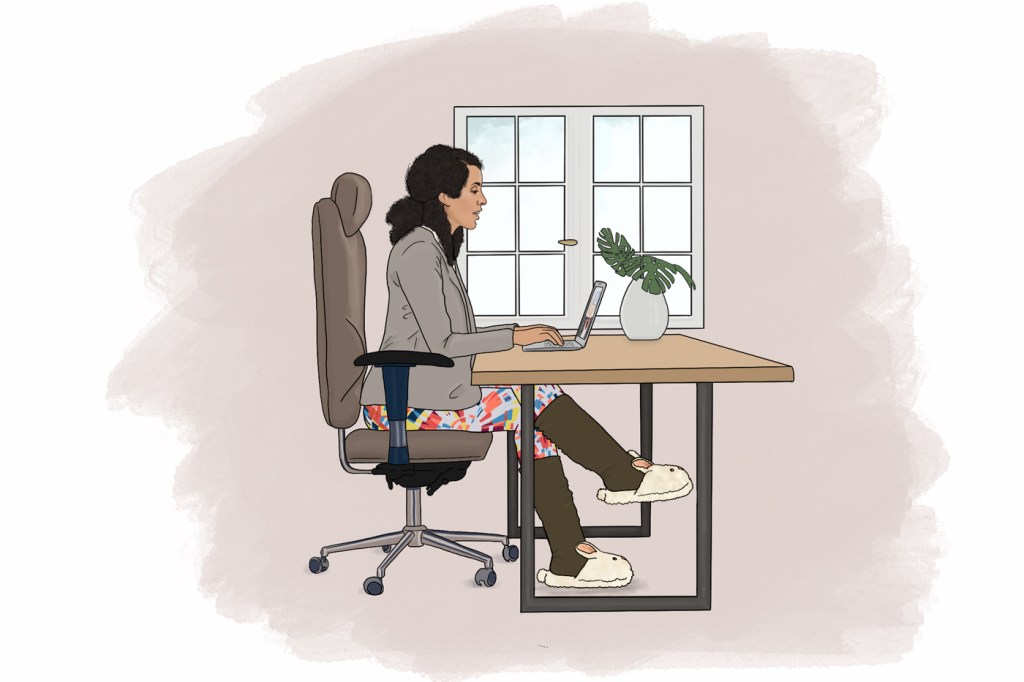Will the COVID-19 pandemic change how people dress for work in the future?

With nowhere to go and hardly anyone to impress, the vast majority of people this year spent more time in their pajamas than they would care to admit.
And it wasn’t just PJs for sleeping. Finding themselves in an extended period of remote work, professionals traded in their heels and loafers for fuzzy socks and slippers, swapped their tailored suits and blazers for comfy sweatshirts and joggers. They let their hair down and let it grow… and grow.
Daniele Mathras, an associate teaching professor of marketing at Northeastern who studies the minimalism movement, says the COVID-19 pandemic has forced people to re-evaluate who they are and how they present themselves.

Daniele Mathras. Northeastern file photo
“People over the last year have developed a new way of being, a new way of defining who they are, maybe prioritizing themselves a little bit more and their comfort, because we need that,” she laughs. “We need that to survive and go on on a day-to-day basis.”
As notions of work attire have changed, the retail landscape has also transformed to meet the needs of the remote worker. Reading the tea leaves on changing consumer habits, more and more clothing companies are adding casual apparel to their inventory and brands are designing for comfort and versatility.
Consumers are prioritizing comfort over style, forgoing buying trendy clothes for basic apparel in neutral colors and comfortable fabrics. Because, let’s face it, who’s going to judge seeing you in the same T-shirt three days in a row? Your cat? Your roommate?
“People feel like they don’t need the social feedback as much,” says Mathras. “They just want to be cozy, and a lot of that has to do with the need to be psychologically cozy, not just physically cozy.”
Some upgraded existing wardrobes and shelled out a little extra for indoor slippers or designer leggings, when in The Before Times, they might have spent that money on, say, wool trousers for work instead.
“When you find yourself wearing them four or five days a week, those are the things that have now become the essentials,” Mathras says.
When workers did dress up, they put in the effort where it counted: picking out a Zoom-friendly top. But even then, they didn’t completely sacrifice comfort, favoring, for example, blazers that were stretchy rather than tailored.
“We want to be professional, but we also want to be comfortable,” Mathras says.
People also tended to veer more toward minimalism this year, says Mathras, eschewing fads and trends and opting for long-lasting staples.
For one of two recent studies on minimalism, Mathras and her research colleagues interviewed more than 30 people who either have a pared-down wardrobe, live in a tiny home or out of their van, or otherwise maintain a minimalist lifestyle. The researchers discovered that these consumers underwent three steps in the transition to lighten their load. The process involved getting rid of things, choosing what to keep, and sometimes even entailed acquiring new possessions.
Throughout the process of paring down, Mathras notes that followers of the minimalist lifestyle visualize who they want to be, and tailor their consumption accordingly.
And yet, the people who were most committed to the minimalist lifestyle were those who did not focus on their ideal, potential self as much as on who they were presently, what they were capable of now, and confronting their limitations, whether those be space, time, or other constraints necessitated by big life changes, such as having children or moving in with a partner.
Mathras learned that she tends to fall into the former category.
“My ideal self is that I would be backpacking out in nature all the time; And in fact, my husband and I have a closet full of backpacking gear,” Mathras laughs. “But we’ve got a 1-year-old and a 3-year-old, and that’s not in my near future to be able to take those kinds of trips.”
In a similar vein, with another colleague at Xavier University, Mathras set out to explore the reasons why some consumers buy fewer, but higher quality products, say an expensive coat. They learned that the more people feel continuity between their present and future selves, the more they are likely to make spending decisions with the future self in mind.
“We found that if we can get consumers to think that they are going to be the same in 10 years and five years as they are right now, then consumers are more likely to shell out money on higher quality things that are going to last,” she says. “It’s obviously better for the environment. It’s better for your wallet. It’s better for so many things.”
Repercussions from the choices consumers are making now will be felt by retailers and the fashion industry for years to come, says Mathras. She anticipates that certain segments of the industry will continue to shrink or go out of business. Especially at risk, she adds, are the bigger brands that are not as agile in their responses.
Now that remote work appears to have become the standard, it will inevitably change the way people dress for work, says Mathras.
“It’s going to be hard to get people back into those uncomfortable clothes after a really long time of being in very comfortable clothes,” she says. “Consumers will be very resistant to that.”
But because people are hardwired for social feedback, it’s also possible that when things do return to normal after the pandemic, consumers will want to reinvent themselves again, propelling renewed demand for stylish wares. And their favorite brands will be listening.
“It could be a big back-to-school kind of thing where everyone’s like, ‘Yeah, I get to buy new clothes, because I haven’t really bought new clothes in a long time,’” says Mathras. “I think that’s how the brands are going to market it when that time comes.”
For media inquiries, please contact Marirose Sartoretto at m.sartoretto@northeastern.edu or 617-373-5718.





